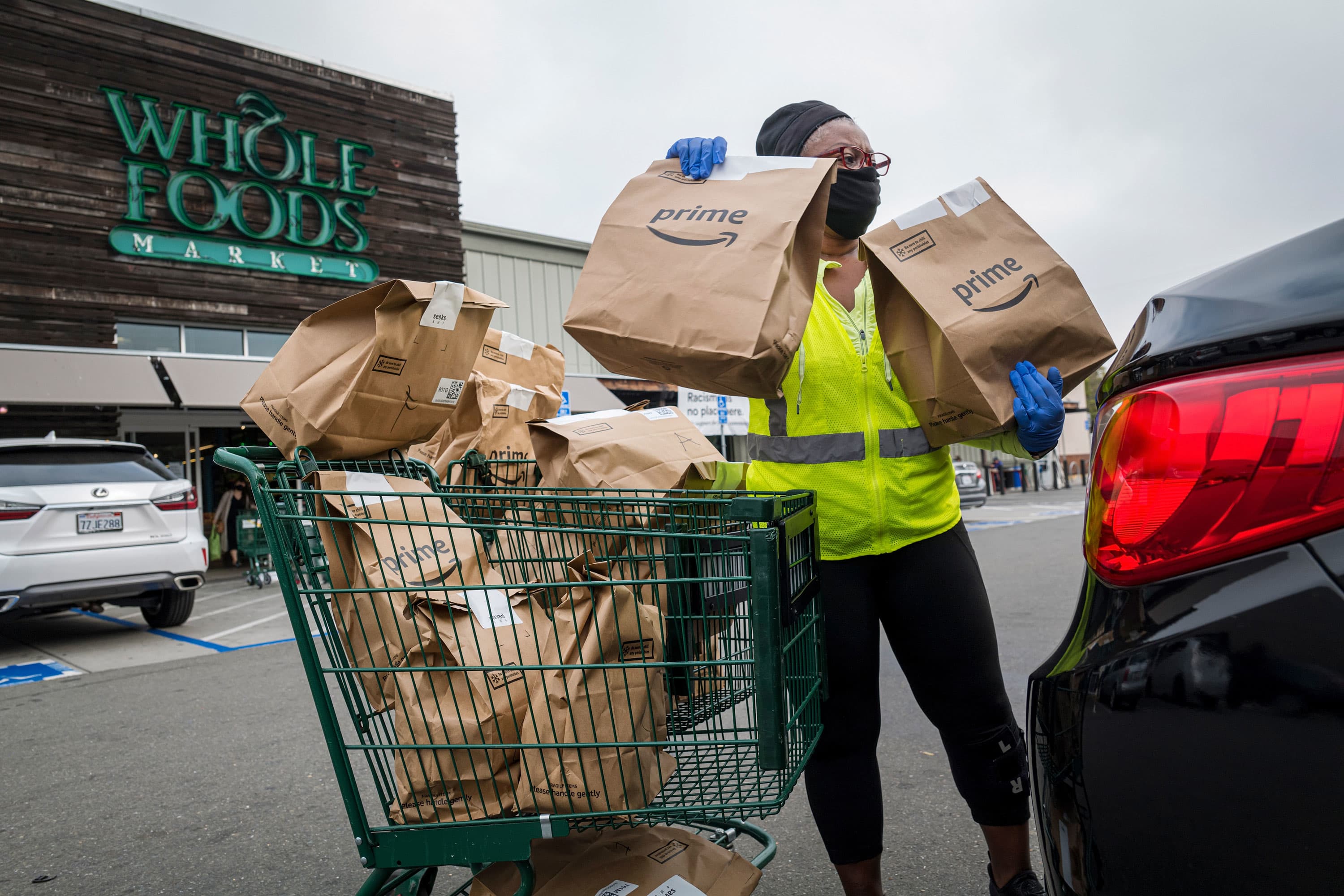
An independent contractor wearing a protective mask and gloves loads Amazon Prime grocery bags into a car outside a Whole Foods Market in Berkeley, California, Oct. 7, 2020.
David Paul Morris | Bloomberg | Getty Images
While Amazon has struggled to find a consistent grocery strategy in the 15 years since it started dabbling in delivery, the Covid-19 pandemic has made one thing abundantly clear: Consumers’ desire to walk the supermarket aisles has diminished.
The rest of the industry is on to that trend as well. With rising competition from Walmart, supermarket chains like ShopRite and Albertsons and apps such as Instacart and DoorDash, Amazon is moving to streamline its grocery-delivery operations.
In late February, Amazon told gig workers who fetch items for delivery that they’ll soon be working for the company’s Whole Foods division, according to a letter that was sent to employees and viewed by CNBC. Instead of offering gig work so contractors can pick up and fill batches of grocery orders, workers will become Whole Foods employees with longer shifts.
“To help continue to offer the best experience for our team and customers, we are transitioning online grocery-fulfillment operations currently operated by Amazon to Whole Foods Market by the end of the year,” the letter says. “This transition will happen slowly for the majority of stores.”
A Whole Foods spokesperson confirmed that the shoppers will become Whole Foods employees in the U.S. by the end of the year.
According to a job description recently posted by Whole Foods, schedules will be made up to three weeks in advance and cover two-week periods. That contrasts with a recent job post for an Amazon shopper that counts “shift flexibility” and the ability to “work as little as four hours per week” as perks.
The change marks Amazon’s latest effort to simplify its sprawling grocery and physical retail operations, which have grown to include two supermarket chains, convenience stores and apparel stores. The e-commerce giant’s biggest expansion came in 2017 with the $13.7 billion purchase of Whole Foods.
Amazon on Wednesday launched one-hour grocery pick-up at all Whole Foods locations nationwide.
Amazon
Last week, Amazon said it will close all of its bookstores, pop-up shops and 4-star stores, which are costly businesses that have failed to gain sales traction. And earlier this year the company shuffled its leadership of physical stores, hiring Tony Hoggett, a veteran of British supermarket chain Tesco, to oversee the unit.
Amazon stressed in its letter that the job change “will create a more unified team culture,” among other benefits.
Some gig workers, though, have voiced displeasure with the change. On Reddit, Amazon shoppers, who valued the former role because of its flexibility, are concerned that they won’t have the same freedom as store employees. They also expressed concerns about possibly having to reapply for the job.
The Whole Foods spokesperson told CNBC that workers won’t have to reapply and that the company aims to provide shoppers with flexible scheduling options.
‘Supposed to be a side gig’
Robert Bruno, a Whole Foods employee in Massachusetts, told CNBC the new structure takes away many of the perks in terms of flexibility, with shoppers free to accept multiple jobs, while the shorter shifts helps them to create their own schedule.
“This is supposed to be a side gig for a lot of people,” Bruno said in an email. “If there are changes in terms of shift scheduling/length, I can easily see a lot of people leaving.”
Some Whole Foods locations are serving as pilots for the change, according to the letter. An employee at one store said workers were expected to fill online orders and assist with other tasks when needed, such as bagging groceries, stocking shelves and operating points of sale.
The person, who wasn’t authorized to speak publicly and asked to remain anonymous, described the new role as requiring quadruple the amount work for the same pay and no flexibility.
In-store shoppers are also expected to achieve certain metrics while they’re on the job, similar to the productivity quotas required for Amazon warehouse and delivery workers.
Amazon provides shoppers with a handheld device to scan items, which are then placed in bags to be delivered to customers. Employees use the Shopper App, installed on the devices, to communicate with customers about item replacements, the employee said.
Amazon monitors activity, such as the so-called Item Not Found rate, or how often employees are unable to locate an item because it might be out of stock. It also tracks how often they offer item replacements and what percentage of grocery-picking jobs shoppers accept. The app will remind workers to continue to shop if they haven’t scanned an item after 15 minutes, the employee said.
Bruno said Amazon also measures what it calls units per hour (UPH), showing how quickly shoppers pick up items. Each Whole Foods location has a certain UPH target, and the number at his store is “66,” he said.
“If it’s pretty far below that number, like in the 40s, then they will talk to you about it and possibly terminate you if it’s too low,” Bruno said.
The Whole Foods spokesperson confirmed that Amazon tracks certain metrics.
“Like most companies, Amazon has performance expectations for every Amazon employee, and measures actual performance against those expectations,” the spokesperson said. “Employee performance is measured and evaluated over a period of time, as we understand that a variety of factors could impact the ability to meet expectations on any given day or hour.”
Amazon shoppers typically fulfill anywhere from 15 to 20 orders per day, though that number can vary if it’s busy or slow, according to a “Day in the Life” video posted by Whole Foods on YouTube.
“Honestly, I’ve gotten more fit doing this job because of the walking and moving around and all of that stuff,” the featured worker says in the video.
This article was originally published on CNBC

